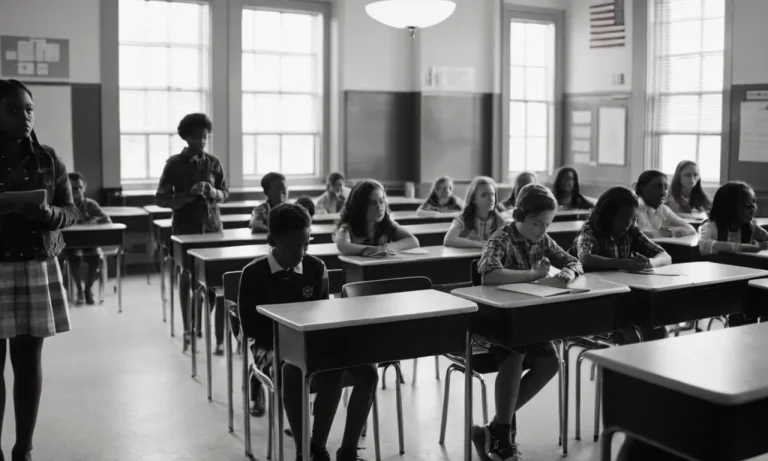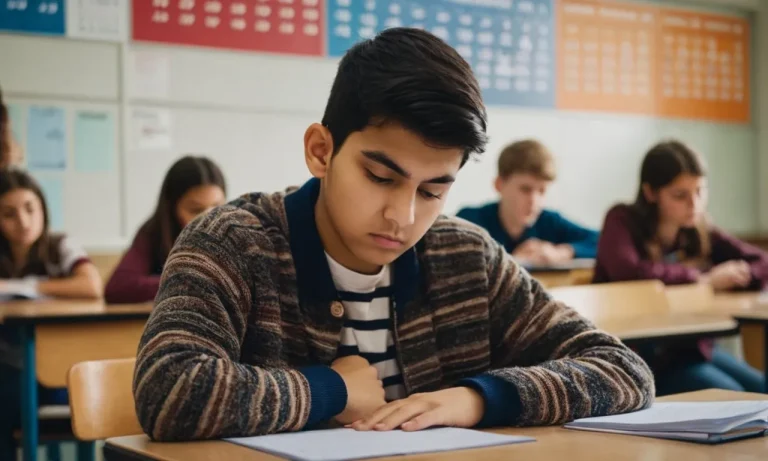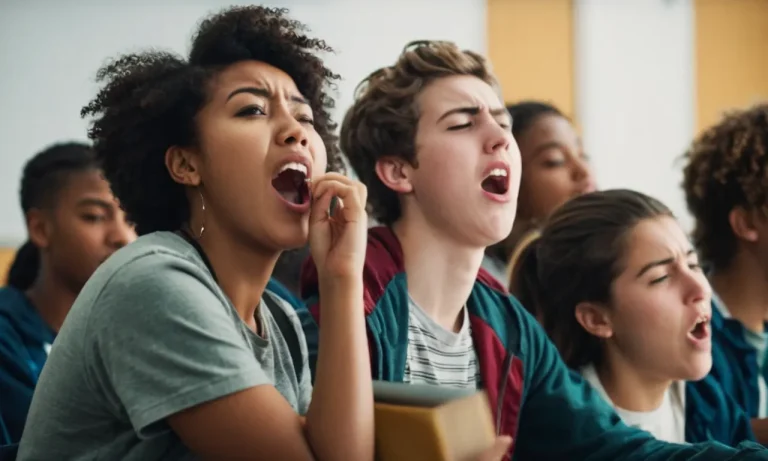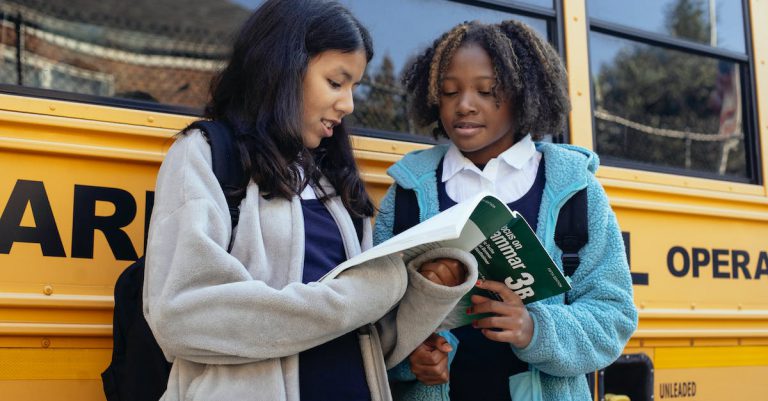Navigating the educational journey of a child can be a daunting task for parents and guardians. One of the most common concerns that arise is the possibility of being held back in elementary school. This decision, often made by teachers and school administrators, can have a profound impact on a child’s academic and personal development.
If you’re short on time, here’s a quick answer to your question: Yes, it is possible for a child to be held back or retained in elementary school if they fail to meet certain academic or developmental milestones.
However, this decision is typically made on a case-by-case basis, taking into account various factors such as academic performance, social and emotional maturity, and the overall well-being of the child.
In this comprehensive article, we will delve into the intricacies of being held back in elementary school. We will explore the reasons behind this decision, the potential impacts it can have on a child’s educational journey, and the strategies that parents and educators can employ to support a child who is at risk of being retained.
Additionally, we will examine the alternative approaches and interventions that may be considered before resorting to retention.
Reasons for Being Held Back in Elementary School
Being held back, or retained, in elementary school is a decision that educators and parents don’t take lightly. While it may seem like a simple solution to give a student more time to catch up academically, the decision is often complex and multifaceted.
There are several key reasons why a child might be held back in elementary school:
Academic Performance
One of the primary reasons for retention is a student’s struggle to meet grade-level academic standards. If a child is consistently performing below expectations in core subjects like reading, writing, and math, despite interventions and additional support, retention may be considered.
According to a study by the National Center for Education Statistics, approximately 2.6% of students were retained in kindergarten through grade 8 during the 2019-2020 school year. However, it’s important to note that retention should not be the only solution, and alternative strategies, such as targeted tutoring or specialized learning plans, should be explored first.
Social and Emotional Maturity
In addition to academic performance, a child’s social and emotional maturity can also play a role in the decision to retain them. If a student struggles to regulate their emotions, follow classroom routines, or interact appropriately with peers, retention may be considered to allow them more time to develop these crucial skills.
According to the California Department of Education, social and emotional development is a key factor in determining a child’s readiness for the next grade level.
Attendance and Behavior Issues
Chronic absenteeism or persistent behavior problems can also contribute to a student being held back. If a child misses a significant number of school days or consistently disrupts the learning environment, they may struggle to keep up with the curriculum and fall behind their peers.
In such cases, retention may be considered to provide the student with additional time to develop better attendance habits and improve their behavior. A study by the Attendance Works initiative found that as many as 8 million students in the U.S. miss nearly a month of school each year, which can have a detrimental impact on their academic progress.
Developmental Delays or Learning Disabilities
Sometimes, a child may be held back due to developmental delays or diagnosed learning disabilities that impact their ability to learn at the same pace as their peers. In these cases, retention can provide additional time for the student to receive specialized support and interventions tailored to their unique needs.
According to the Centers for Disease Control and Prevention (CDC), approximately 1 in 6 children in the U.S. have one or more developmental disabilities or delays. Early identification and appropriate interventions are crucial for supporting these students and ensuring their academic success.
Ultimately, the decision to retain a student in elementary school should be made on a case-by-case basis, considering the child’s overall development, academic progress, and individual needs. It’s a delicate balance between providing additional time for growth and avoiding the potential emotional and social consequences of being separated from their peer group.
Open communication between educators, parents, and support professionals is essential to ensure the best possible outcome for the student.
Potential Impacts of Being Held Back
Academic Implications
Being held back in elementary school can have significant academic implications for a child. While the intention is to provide additional time for the student to catch up academically, research suggests that retention may not always lead to improved academic performance.
According to a study by the National Association of School Psychologists (https://www.nasponline.org/resources-and-publications/resources-and-podcasts/school-psychology-resources/student-retention-and-social-promotion/retention-and-student-achievement), retained students often fall behind again within a few years, and the achievement gap between them and their peers widens over time.
Social and Emotional Consequences
Being held back can also have social and emotional consequences for a child. They may feel embarrassed, stigmatized, or isolated from their peers. This can lead to a decline in self-esteem and confidence, as well as an increased risk of developing social and emotional problems.
A study published in the Journal of Educational Psychology (https://psycnet.apa.org/record/2018-39021-001) found that retained students experienced higher levels of anxiety, depression, and behavioral problems compared to their promoted peers.
Self-Esteem and Confidence
Being held back can be a significant blow to a child’s self-esteem and confidence. They may feel like they have failed or are not as capable as their peers. This can lead to a negative self-perception and a lack of motivation to succeed academically.
As a result, they may develop a fear of failure or become disengaged from learning altogether. According to the American Psychological Association (https://www.apa.org/topics/self-esteem), low self-esteem can have long-lasting effects on a child’s mental health and overall well-being.
Long-Term Effects
The impacts of being held back in elementary school can extend far beyond the immediate academic and social consequences. Research has shown that students who are retained are more likely to drop out of high school and have lower educational attainment overall.
A study by the National Center for Education Statistics (https://nces.ed.gov/pubs2006/2006601.pdf) found that students who were held back were twice as likely to drop out of high school compared to their peers who were never retained. Additionally, being held back can have long-term effects on a child’s self-confidence, self-esteem, and overall well-being, which can impact their future success and happiness.
Supporting a Child Who is at Risk of Being Held Back
If your child is at risk of being held back in elementary school, it’s crucial to take proactive steps to support their academic, social, and emotional growth. Here are some strategies to consider:
Collaboration with Teachers and School
Open and consistent communication with your child’s teachers and school administrators is key. Attend parent-teacher conferences, share your concerns, and work together to develop an action plan. Understand the school’s policies on retention and promotion criteria, and ask for specific feedback on areas where your child needs improvement.
Check out resources like Edutopia’s tips for parents on collaborating with teachers effectively.
Providing Academic Support
Identify your child’s strengths and weaknesses, and provide targeted support in areas where they struggle. Consider hiring a tutor or enrolling them in after-school programs or summer enrichment activities.
Encourage daily reading, practice math skills, and explore educational apps or websites like Khan Academy that offer engaging learning resources. According to the National Center for Education Statistics, students who receive additional academic support are more likely to improve their performance and avoid retention.
Addressing Social and Emotional Needs
Being at risk of retention can take an emotional toll on a child. Address any underlying social or emotional issues that may be impacting their performance. Seek support from a school counselor or child psychologist if needed.
Encourage your child to participate in extracurricular activities that foster social skills, self-confidence, and a sense of belonging. 😊 Celebrate their strengths and efforts, and provide a nurturing environment at home.
Advocating for Your Child
If you disagree with the school’s decision to retain your child, be prepared to advocate for them respectfully. Request a formal meeting with the principal and relevant staff members to discuss your concerns and present any supporting evidence or documentation.
Understand your rights and the school’s appeal process. Consider seeking guidance from parent advocacy groups or educational consultants if needed. Remember, you are your child’s best advocate, and your active involvement can make a significant difference in their academic journey.
By collaborating with the school, providing targeted support, addressing social and emotional needs, and advocating for your child, you can increase their chances of success and ensure they receive the resources and support they need to thrive.
Alternative Approaches and Interventions
When students face academic challenges in elementary school, holding them back may not always be the best solution. Instead, there are several alternative approaches and interventions that can help them get back on track and thrive in their educational journey. Here are some effective strategies:
Individualized Education Plans (IEPs)
For students with learning disabilities, developmental delays, or other special needs, an Individualized Education Plan (IEP) can be a game-changer. As outlined by the Understood.org website, an IEP is a legal document that outlines the specific accommodations, modifications, and support services a student requires to succeed academically.
By tailoring the learning experience to their unique needs, an IEP can help bridge the gap and ensure they receive the appropriate assistance.
Tutoring and Supplemental Instruction
Sometimes, all a student needs is a little extra help and attention. Tutoring, whether one-on-one or in small groups, can provide the personalized support and focused instruction that may be lacking in a large classroom setting.
According to a study by EdWeek, students who received high-dosage tutoring saw significant gains in reading and math, with some even achieving two years’ worth of growth in a single academic year. 😊 Supplemental instruction, such as after-school programs or summer camps, can also reinforce concepts and help students catch up.
Summer School or Enrichment Programs
Summer breaks can be a valuable opportunity for students to catch up on their studies or explore new areas of interest. Summer school programs offer a focused and intensive learning environment, allowing students to concentrate on specific subjects or skills they may have struggled with during the regular school year.
Alternatively, enrichment programs can provide a fun and engaging way to keep their minds active while exploring topics they’re passionate about, potentially reigniting their love for learning.
Transitional or Multiage Classrooms
In some cases, a traditional single-grade classroom may not be the best fit for a student’s needs. Transitional or multiage classrooms can provide a more flexible and nurturing environment by grouping students based on their abilities rather than strictly by age or grade level.
This approach allows students to progress at their own pace, without the pressure of being “held back” or advanced too quickly. According to research by Edutopia, multiage classrooms can foster a deeper understanding of concepts, promote social and emotional growth, and create a more inclusive learning community.
Remember, every student is unique, and finding the right approach or combination of interventions may take some trial and error. By exploring these alternatives and working closely with educators and support teams, you can help ensure your child receives the personalized attention and resources they need to thrive academically and personally.
👏
Conclusion
The decision to hold back a child in elementary school is a complex and multifaceted one, requiring careful consideration of various factors. While retention may be necessary in certain cases, it is crucial to explore alternative approaches and interventions that can support a child’s academic and personal growth.
Ultimately, the well-being and success of the child should be the primary focus. By fostering open communication between parents, educators, and support professionals, and by implementing tailored strategies and resources, we can ensure that every child has the opportunity to thrive and reach their full potential.
Remember, being held back is not a reflection of a child’s abilities or worth; it is a temporary setback that, with the right support and guidance, can be overcome. By working together and prioritizing the child’s needs, we can navigate this challenging situation with empathy, understanding, and a commitment to their long-term success.






